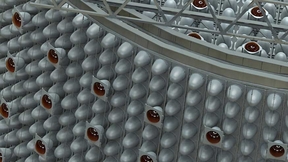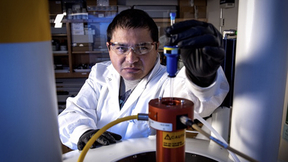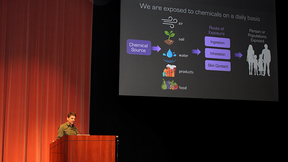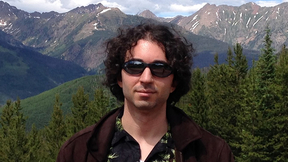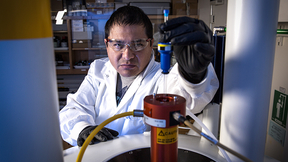Back
Physical and Life Sciences
Machine learning models could save lives through personalized sepsis diagnostics
Researchers and clinicians may be able to track the progression of sepsis, a potentially life-threatening condition characterized by an extreme reaction to infection, with more precision and confidence using machine learning models developed at Lawrence Livermore National Laboratory (LLNL) in conjunction with health care provider Kaiser Permanente. Typical diagnostic tools…
Lab's Data Science Institute brings best minds in AI, machine learning under one umbrella
Machine learning. Deep learning. Artificial intelligence. Computer vision. Big data analytics. These aren’t just techie buzzwords — they’re all areas of research that fall under the sweeping term "data science." So how does a national laboratory, with researchers exploring all of these areas and more, coalesce these disciplines into a unified group? Launched earlier this…
Martovetsky's quest for carbon-free power endures at the world's largest fusion experiment
Growing up in Protvino, Russia, in the 1960s — home to the largest particle accelerator in the world when it launched in 1967 — Lawrence Livermore National Laboratory (LLNL) scientist Nicolai Martovetsky quickly became fascinated with physics and math. "Protvino was one of the towns in Russia built for science, and I was kind of a curious kid by nature," he said. "At…
Lab scientists successfully print glass optics
For the first time, researchers at Lawrence Livermore National Laboratory (LLNL) have successfully 3D-printed optical-quality glasses, on par with commercial glass products currently available on the market. In a study published in the journal Advanced Materials Technologies, LLNL scientists and engineers describe successfully printing small test pieces from Lab-developed…
Lawrence Livermore to lead United States-United Kingdom consortium for demonstrating remote monitoring of nuclear reactors
LIVERMORE—Harnessing the unusual characteristics of the elusive subatomic particles known as antineutrinos, Lawrence Livermore National Laboratory (LLNL) will lead a new international multi-laboratory and university collaboration for nonproliferation research. The program will support the development of detection hardware and algorithms to enable improved nonproliferation…
A Solid Hydrogen-Storage Solution
At Lawrence Livermore, early-stage research to store hydrogen in solid materials, such as metal hydrides, could be a boon for advancing the hydrogen fuel economy. New results from these efforts, gleaned from this multidisciplinary approach, are reinvigorating scientists engaged in creating a technology infrastructure to produce, distribute, and store hydrogen for fuel cell…
Lab scientists optimizing high performance fuels for advanced internal combustion engines
In support of the Department of Energy’s (DOE) Co-Optimization of Fuels & Engines (Co-Optima) initiative, Lawrence Livermore National Laboratory (LLNL) scientists are developing models of high performance fuels to see how they would perform in advanced internal combustion engines. The DOE national research effort is providing industry with the scientific underpinnings…
Breaking the Law: Lawrence Livermore, Department of Energy look to shatter Moore's Law through quantum computing
The laws of quantum physics impact daily life in rippling undercurrents few people are aware of, from the batteries in our smartphones to the energy generated from solar panels. As the Department of Energy (DOE) and its national laboratories explore the frontiers of quantum science, such as calculating the energy levels of a single atom or how molecules fit together, more…
FSC earns 8th straight A in OPCW tests
During its 15 years as a certified laboratory for the Organization for the Prohibition of Chemical Weapons (OPCW), a score of Lawrence Livermore National Laboratory (LLNL) chemists have developed some first-rate habits. One of them is earning A grades on the organization's environmental proficiency tests. In recently announced results, LLNL earned its eighth straight A…
Biomedical Technology Accelerates into ‘Science on Saturday’ Program
Lawrence Livermore National Laboratory’s (LLNL’s) educational outreach program Science on Saturday returned in February for a season of Marvelous Machines. Held annually at the Bankhead Theater in downtown Livermore, the lecture series offers local students and the public a peek into LLNL’s recent research. In a February 10 presentation titled “Biomedical Accelerator Mass…
Lab scientists to improve energy efficiency of copper catalysts that convert CO2 to methane
Lawrence Livermore National Laboratory (LLNL) researchers have received $1 million from the Department of Energy to improve the energy efficiency of copper-based catalysts to convert carbon dioxide into methane and other valuable hydrocarbon products. Led by LLNL’s Juergen Biener, the project will help meet the nation’s future energy needs by converting low-cost, abundant…
Lab employee and retiree named fellows
Two researchers affiliated with Lawrence Livermore National Laboratory (LLNL) -- a current employee and a retiree -- have been named fellows of the international Combustion Institute (CI). Bill Pitz, a combustion scientist in the Lab’s Materials Science Division, and Charlie Westbrook, a retired Lab employee, were announced in mid-February as fellows of the institute. They…
Unexpected metal behavior at Earth’s core conditions
At temperatures and pressures typically encountered on Earth’s surface, metallic elements naturally form compounds with electronegative elements. For example, iron reacts with oxygen to form rust, Fe2O3. In contrast, noble gas elements such as argon, neon, and xenon show very little reactivity with other elements. Under the extreme conditions at Earth’s core, however,…
Earth's core metals react well to electrons
At temperatures and pressures found on Earth’s surface, metallic elements are electropositive and lose their valence electrons to form positively charged cations. Metals have free electrons that naturally form compounds with electronegative elements. For example, iron reacts with oxygen to form Fe2O3 – commonly referred to as rust. In contrast, noble gas elements (NGEs),…
Pushing Boundaries in Plasma Physics: Michael Campanell Brings His Revolutionary Model to LLNL
When Michael Campanell was a graduate student at the Princeton Plasma Physics Laboratory, he noticed something unusual: the boundary physics simulation he was running wasn’t behaving the way it was supposed to. A century of plasma theory predicted one thing, but Campanell’s simulation was doing another. This was the impetus for his thesis, and a big challenge to the status…
Forensic Science Center earns 8th straight ‘A’ in OPCW tests
During their 15 years as a certified laboratory for the Organization for the Prohibition of Chemical Weapons (OPCW), a score of LLNL chemists have developed some first-rate habits. One of them is earning “A” grades on the organization’s environmental proficiency tests. In recently-announced results, LLNL earned its eighth straight “A” grade during last fall’s OPCW…
Scientists find 'frustration' in battery materials
Adding carbon atoms to a new type of solid lithium ion battery could make it charge faster and more safely. Solid-state lithium-ion batteries can provide dramatically improved safety, voltage and energy density compared with today’s batteries, which use liquid components. They could be used in electric vehicles, as well as in power electronics. However, they are still in…
Drones deliver green transportation option
By getting your next package delivered by drone, you could be saving energy, but only if companies deploy drones sensibly. New research by Lawrence Livermore National Laboratory (LLNL), Carnegie Mellon University, SRI International and the University of Colorado at Boulder shows that drone-based delivery could reduce greenhouse gas emissions and energy use in the…
Protein that prevents further cartilage damage
There may be a protein in the body that hinders cartilage degradation in patients with a torn anterior cruciate ligament (ACL). Lawrence Livermore National Laboratory (LLNL) scientists performed in vivo experiments on animal models of post traumatic osteoarthritis and found that sclerostin (a protein that in humans is encoded by the Sost gene), acts as a protective…
Hayward fault earthquake simulations increase fidelity of ground motions
In the next 30 years, there is a one-in-three chance that the Hayward fault will rupture with a 6.7 magnitude or higher earthquake, according to the United States Geologic Survey (USGS). Such an earthquake will cause widespread damage to structures, transportation and utilities, as well as economic and social disruption in the East Bay. Lawrence Livermore (LLNL) and…






